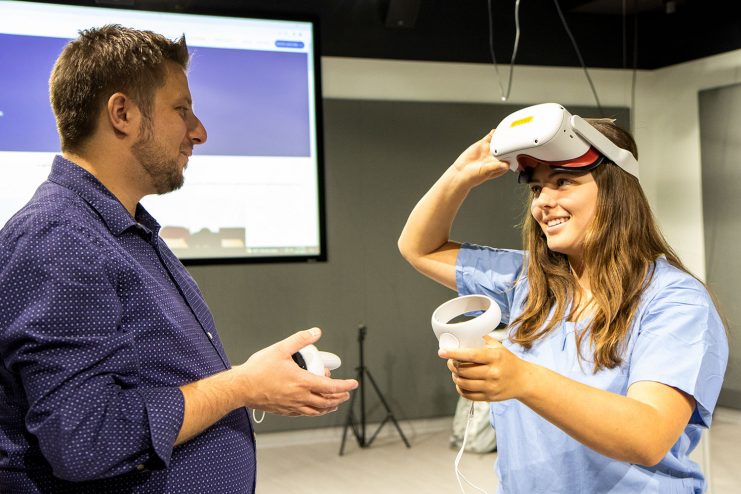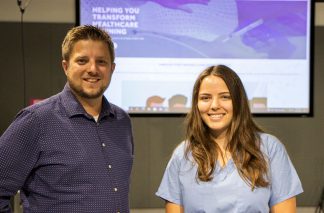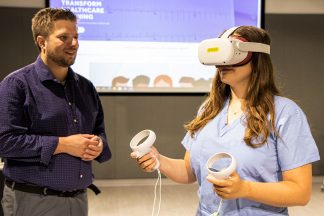By Allison Campbell-Jensen
“Do no harm” is a major tenet of the physicians’ creed, in the Hippocratic Oath or a modernized version of it. While medical students are in the process of learning to become practicing physicians, however, they may find themselves on clinical rotations in clinics or hospital rooms where a mistake in care might have dire consequences for patients.
To reduce risk and improve training, Medical School students participate in simulated clinical experiences where standardized patients — real people trained to show up with certain symptoms — interact with physicians-to-be in a room set up like a clinic or an emergency room.
Now, the U’s medical students who intend to go into emergency medicine are testing another option, too: Virtual Reality (VR) simulation for their Emergency Medicine Advanced Rotation.
VR offers a great alternative, says Mary Ann McNeil, Administrative Manager of the Medical School’s Emergency Medicine department, for a generation of whom many have immersed themselves in video games.
During the pandemic time, VR simulation also promises to help students learn to work with patients in an active, experiential-learning type situation while keeping them out of COVID’s way.
Libraries’ essential support for VR
With the help of Charlie Heinz, Libraries Multimedia Specialist in the Health Sciences Library (HSL), about 30 U of M medical students have been trying out this different route to emergency department knowledge this summer.
Heinz metaphorically sets the table for those entering this specially offered advanced clinical rotation by gathering the medical students around a long table in the middle of HSL’s Virtual Reality Studio. As he introduces them to VR equipment and to the software they will be using, he serves up answers to common questions:
- What if I wear glasses?
- How do I adjust the headset for comfort and clarity?
- What if I am prone to motion sickness?
- Can I do virtual reality?
- What kind of computer do I need to run the software? (No computer required! The students used Meta Quest 2 headsets, loaned from the University of Minnesota Libraries, which do not require a computer.)
- My apartment is tiny — am I going to be able to simulate walking to the sink to wash my hands, then turning and taking several steps to the patient, if I don’t have that amount of room IRL (in real life)?
Making it real-ish in VR
“I’ve got to say: We’ve got a phenomenal Health Sciences Library.”
—Mary Ann McNeil, Administrative Manager of the Medical School’s Emergency Medicine department
McNeil is grateful that HSL is lending the VR headsets at no charge; the students check them out for three weeks.
“I’ve got to say: We’ve got a phenomenal Health Sciences Library,” she says.
The students enter one of the 10 patient scenarios — the clinicals are timed — to see how efficiently and accurately they can help pin down the causes of pain or other issues that the VR patients are expressing. They ask questions; they move around the patient; they strive to provide the best care possible in an urgent, albeit virtual, situation.
“Emergency medicine assessments are different than other specialties because patients are undifferentiated (it’s not clear what their trouble is) and very, very ill,” McNeil says. After the virtual patient encounter, the medical students meet in a small group with a facilitator, to discuss what they learned. If they wish, they can re-do the simulations, too.
“We’re not replacing traditional methods,” Heinz says. “It [VR] is a complement to other strategies, such as those used in the simulation suites right next door” to the VR Studio in M Simulation.
As a side benefit to the experience, students are able to apply critical thinking skills around VR — a technology that is shaping the future of health care teaching and practice. By understanding its benefits, as well as its limitations students can understand a bigger context around VR applications such as costs, learning curves, and even motion sickness that VR users can experience.
“The jury’s out until they are accepted” into emergency medicine residency programs, McNeil says — but the students reported feeling well introduced to the VR capabilities and every one so far has found the simulations useful, to some degree.
“The important thing about simulation is not necessarily the scenario itself, but the debrief afterwards,” McNeil says. “How the debrief is handled is incredibly important. It’s not a right or wrong [thing]; it’s a ‘Let’s talk about medical decision-making, and how you came to that decision.’”
One well-educated student’s view
The VR approach suits Mitchell Butterbaugh, a fourth-year medical student. Butterbaugh not only already has trained as a paramedic but also educates others about emergency medical services at a local hospital. His goal: To become an emergency department physician.
He is excited by the possibilities of VR — that it clearly presents many of the challenges that an emerging physician might encounter, all at one time. The software package initially chosen, however, did not meet his expectations: It did not fully replicate an emergency room situation with an immersive environment.
He agreed with another student, who said it was not realistic to be able to accomplish only one activity at a time. A physician should be able to feel a patient’s abdomen or listen to their heart while simultaneously asking a question of the patient.
Once the right program is identified — and Butterbaugh has been in conversation with the head of Emergency Medicine at the U about possible choices — he feels confident that VR will be a great tool for emergency medicine physician training.
There’s another advantage to VR, with any program. “It’s a safe environment,” says McNeil. “You won’t hurt anybody.”







